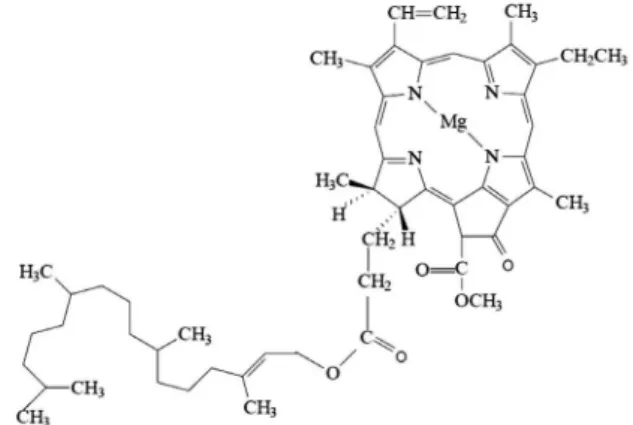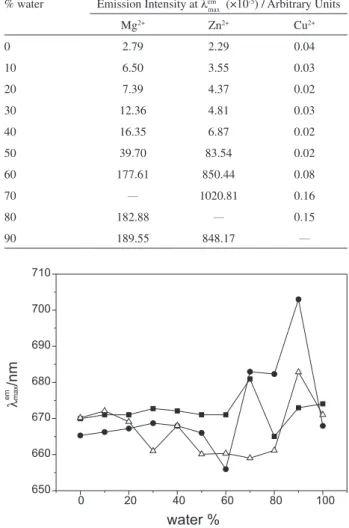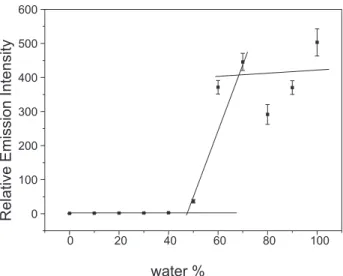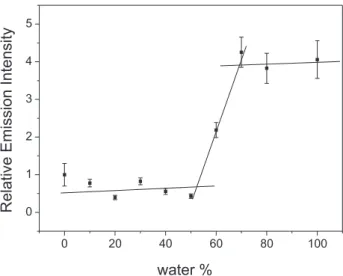Ar
ti
cle
0103 - 5053 $6.00+0.00
*e-mail: huederpaulo@yahoo.com.br
Metallochlorophylls of Magnesium, Copper and Zinc: Evaluation of the Inluence of the
First Coordination Sphere on their Solvatochromism and Aggregation Properties
Leonardo M. Moreira,a Adriana Lima,a Rafael R. S. Soares,b Vagner R. Batistela,b Adriana P. Gerola,b Noboru Hioka,b Juliano A. Bonacin,c Divinomar Severino,c Mauricio S. Baptista,c Antônio E. da Hora
Machado,d Máira R. Rodrigues,a Lúcia Codognotoa and Hueder P. M. de Oliveira*,a
aUniversidade Camilo Castelo Branco, 12247-004 São José dos Campos-SP, Brazil
bDepartamento de Química,Universidade Estadual de Maringá, 87020-900 Maringá-PR, Brazil
cDepartamento de Bioquímica, Instituto de Química, Universidade de São Paulo,
05508-900 São Paulo-SP, Brazil
dInstituto de Química, Universidade Federal de Uberlândia, 38408-100 Uberlândia-MG, Brazil
No presente estudo, o papel de diferentes centros metálicos (magnésio, zinco e cobre) sobre o caráter hidrofílico de metalocloroilas foi avaliado. O solvatocromismo, assim como o processo de agregação para esses compostos, em misturas água/etanol foram avaliados usando medidas de luorescência e de espalhamento de luz ressonante (ELR), visando caracterizar o comportamento desses compostos. Independente da metalocloroila estudada, a presença de ao menos 60% de água resulta em incremento considerável na emissão de luorescência apresentada por esses compostos. Isso, provavelmente, é uma conseqüência direta de uma menor agregação, o que é conirmado pelos resultados de ELR. Adicionalmente, os resultados sugerem que as cloroilas de magnésio e de zinco devem ser promissores agentes fototerapêuticos para emprego em Terapia Fotodinâmica.
In this study the role of different metal centers (magnesium, zinc and copper) on the enhancement of the hydrophilic character of metallochlorophylls, was evaluated. The solvatochromism as well as the aggregation process for these compounds in water/ethanol mixtures at different volume ratios were evaluated using Fluorescence, and Resonant Light Scattering (RLS) measurements, aiming to characterize the behavior of these compounds. Independently on the studied metallochlorophyll, the presence of at least 60% of water results in a considerable increase in the luorescence emission, probably a direct consequence of a lower aggregation of these compounds, which is conirmed by the results from RLS measurements. Additionally, the results suggest that magnesium and zinc chlorophyll should be promising phototherapeutic agents for Photodynamic Therapy.
Keywords: fluorescence spectroscopy, resonant light scattering, metallochlorophylls, photodynamic therapy
Introduction
Photosynthetic pigments represent a kind of “lifeblood” of all photoautotrophic organisms. There are basically three classes of natural photosynthetic pigments: chlorophylls, carothenoids and phycobilins.1 In nature, there are
approximately 10 types of chlorophylls, isolated from the green part of the plants. In some organisms only chlorophyll is detected, while in other species, the main chlorophyll is accompanied by other green pigments. This principal component is the chlorophyll α (Figure 1),
which is found together with the chlorophylls b, c, d and the protochlorophyll.2 It is important to register that the
version of chlorophyll α without metallic center, where
Mg2+ is substituted by two hydrogen atoms, is known
as pheophytin α, which has been previously evaluated.3
This derivative can be obtained by the acid hydrolysis of chlorophyll α (Figure 2).4
Chlorophyll α has a ubiquitous role as electron donor
in photochemical reactions of oxygenic photosynthesis, in which two kinds of photosystem, namely photosystem I (PSI) and photosystem II (PSII), cooperatively drive photosynthetic electron low from water to NADP+. The
Indeed, PS-I and PS-II have been intensively studied with different aims in the literature.6-8 It is a porphyrin derivative
classiied as chlorin, being metallated with Mg2+ (Figure 1).
Differently from porphyrins, the molar absorptivity of the Q bands of chlorin (assigned to the S0→S
1π-π* electronic
transition) is considerably intense,9,10 occurring into the
“Phototherapeutic Window”.10 Besides, this class of
compounds tends to present considerably long-lived triplet excited states, being promising phototherapeutic agents in Photodynamic Therapy (PDT).10-17
However, one of the main limitations of chlorins and other promising phototherapeutic agents for PDT is related to the high hydrophobic character of these compounds.10,17
The high hydrophobic character tends to provoke signiicant aggregation of these macrocycles in water or physiological medium. Consequently, several trials have been developed in order to use metallochlorins as phototherapeutic agents for PDT, since the presence of the metallic center should decrease the hydrophobic character of the macrocycle.18
In this way, several researchers have focused their efforts on macrocyclic metallic complexes as prototypes of new photosensitizers (PS) in order to improve the eficiency of their photodynamic action in PDT.
In the present article, the solvatochromism as well as the self-assembly process for magnesium, zinc and copper
chlorophylls were evaluated using luorescence emission spectroscopy and Resonant Light Scattering (RLS).
Experimental
Eleven water/ethanol (v/v) mixtures containing m a g n e s i u m , z i n c o r c o p p e r c h l o r o p hy l l ( C h l , 1.44 × 10-5 mol L-1) were investigated. The water employed
in the preparation of these mixtures presented Milli-Q degree, while ethanol was of spectroscopic degree.
Chlorophyll α was extracted from spinach following a
procedure proposed by Dolphin.2 Pheophytin was obtained
from chlorophyll α by a reaction with hydrochloric acid
(2 mol L-1). Zinc and copper chlorophylls were obtained
by this procedure: chlorophyll α was dissolved in a
2:1 (v/v) chloroform/glacial acetic acid mixture. After that, an excess of zinc or copper acetate was added to this mixture, which was maintained under magnetic stirring, at room temperature, for two hours. The reaction mixture was washed with water to eliminate the excess of metallic ions. The puriication of these compounds was carried out using thin layer circular chromatography-Chromatotron (Harrison Research, model 8924) with silica as stationary phase and a mixture of petroleum ether/ethanol (95:5, v/v) as eluent. The characterization of these compounds was performed by 1H NMR (Varian, Gemini 300 MHz).
The excitation and emission spectra were obtained using a Jobin-Yvon Spex FloroMax-2 spectroluorimeter (Emission slit = Excitation slit = 1 mm) and in a Ocean Optics spectroluorimeter. The emission spectra were done using the maximum excitation intensity of both compounds. Resonant Light Scattering (RLS) spectra were obtained, in the range between 200 and 800 nm, with ∆λ = 0 nm, in
order to verify the occurrence of auto-aggregation. All measurements were done at 298 K. The spectra were obtained using 1 cm of optical pathway quartz cuvettes.
Results and Discussion
Figure 3 presents the emission spectra of magnesium, zinc and copper chlorophylls, in ethanol. The maximum emission observed for zinc chlorophyll is slightly blue-shifted when compared with the one corresponding to chlorophyll α or copper chlorophyll. This effect is probably
related to a minor contact between solvent and macrocycle for zinc chlorophyll. Being a metal cation from 2A family, Mg2+ presents a signiicant hygroscopic character,
which must accentuate the hydrophilic character of the chlorin, favoring the accessibility of polar solvents to the macrocycle. The higher contact between ethanol and/or water and the macrocycle, in the case of magnesium
Figure 1. Structural representation of chlorophyll α.
Figure 2. Schematic representation of the conversion of chlorophyll α to
as metallic center, tends to affect more intensely the π*
orbital as function of its more polarizable and accessible (external) character, reducing the energy gap between π
and π* orbitals. This results in the observed red-shift of
the emission band corresponding to the π-π* electronic
transition of chlorophyll α when compared with the zinc
as coordination center. A similar behavior is observed for copper chlorophyll.
Figure 3 (Inset) suggests the occurrence of an intense luorescence quenching in copper chlorophyll, certainly provoked by the paramagnetism of Cu2+. Furthermore,
the speciic disposition of the energy levels of the ligand ield distribution in Cu+2 must favor a signiicant energy
transfer, possibly associated to Dexter’s mechanism. The synergism between these characteristics must favor the changes reported in this paper.
It is well established that metallic complexes presenting ad9 electronic coniguration, as the coordination compounds
of Cu2+, favor a hexacoordinate coniguration, with the axial
coordination sites occupied by solvent molecules. Indeed, water and ethanol are Lewis bases, considered potential
σ-donor ligands, capable to coordinate with Cu2+, which
tend to originate a hexacoordinate metallic complex with a peculiar tetragonal distortion (Jahn-Teller Effect). However, it is known that the presence of paramagnetic metals in macrocyclic compounds results in very short triplet lifetimes, imposing a severe limitation on the usefulness of such sensitizers as photodynamic agents.19
It is evident that, for the chlorophyll derivatives studied in this work, the presence of the phytol chain (Figure 1) will introduce some hydrophobic character on these compounds.17,18 However, considering the small electronic
coupling between this alkyl chain and the macrocycle, the presence of this group certainly will result in a minimal
effect on the macrocycle solvation with polar solvents, as reported in this work.
The data from Table 1 and Figure 4 suggest that the luorescence of these chlorophyll derivatives seems to have an important correlation with the level of solvation of the macrocycle with mixtures of polar solvents. However, the observed trends are minimal for copper chlorophyll. The data from Table 1 demonstrate that IF(max) for copper chlorophyll have extremely low intensities when compared to magnesium or zinc chlorophylls. In fact, copper chlorophyll almost does not present luorescence due to the paramagnetism of this metal ion. On the other hand, the difference in the values of IF(max) between zinc and magnesium chlorophylls is very low.
For these three metallochlorophylls, the luorescence intensity at the λe
m m
ax (IF(max)) tends to increase (Table 1),
mainly between 40 and 60% of water in the ethanol/water
Figure 3. Emission spectra of the studied chlorophylls (Mg2+ — ; Zn2+----)
in ethanol at 298.15 K. Inset: Emission spectrum of Cu2+ chlorophyll
(···) in ethanol at 298.15 K.
Table 1. Maximum intensities of luorescence emission for the studied
metallochlorophylls
% water Emission Intensity at λe m
m ax (×10
-5) / Arbitrary Units
Mg2+ Zn2+ Cu2+
0 2.79 2.29 0.04
10 6.50 3.55 0.03
20 7.39 4.37 0.02
30 12.36 4.81 0.03
40 16.35 6.87 0.02
50 39.70 83.54 0.02
60 177.61 850.44 0.08
70 ___ 1020.81 0.16
80 182.88 ___ 0.15
90 189.55 848.17 ___
Figure 4. Variation of the emission maximum intensity for the studied
chlorophylls (, Mg2+; , Zn2+; , Cu2+) as function of solvent
mixture, mainly for zinc and magnesium chlorophylls. For copper chlorophyll, the increase of IF(max) is more discrete (Figure 3, Inset and Table 1), occurring for water proportions between 50 and 65%.
Figure 4 presents the correlation between the emission wavelength at the emission maximum (λe
m m
ax) and the % of
water in the solvent mixture. For magnesium chlorophyll, the λe
m m
ax tends to suffer a red shift as the water content
increases in the mixture, until about 70% of water, evidently a consequence of an eficient solvation of the macrocycle, inluenced by the metal centre. The improvement in the solvation implies in the diminish of the energy gap between the π and π* states. A similar behavior is observed for
the absorption spectra of these compounds (not shown). For copper chlorophyll an opposite effect is initially observed, probably due to the differentiated characteristics of this complex, for which the excited state deactivation is improved by the paramagnetism of the metal centre.19
However, between 80 and 90% of water, although not comparable with the observed for magnesium or zinc chlorophylls, a small trend of red shift of the emission band is also observed.
For zinc chlorophyll, the solvation also exerts a signiicant role on its luorescence (Table 1). A signiicant red shift is observed for the emission band of this compound in the range between 60 and 90% of water (Figure 4). However, below this range, between 0 and 50% of water, a minimal spectral shift is observed.
For magnesium chlorophyll, in the range between 40 and 60% of water (Figure 5), an abrupt transition in the emission intensities is observed. Above 60% of water the absorption (not shown) and emission intensities reach an optimal condition, indicating that the range between 60 and 100% of water, for the water/ethanol mixtures, constitutes
a potential ratio to trials using this chlorophyll derivative as promising PS for PDT.
Figure 6 shows, for zinc chlorophyll, that a similar abrupt transition in the emission intensity is observed the range between 50 and 70% of water. Above 70% of water, the absorption (not shown) and emission intensities reach an optimal for the use of this chlorophyll derivative in assays aiming to establish this compound as PS for PDT.
In fact, the intense absorption and emission intensities presented by these two chlorophyll derivatives are relevant parameters that suggest that, under the presented solvation conditions, these macrocyclic compounds can be capable to sensitize Reactive Oxygen Species (ROS), such as singlet oxygen, an important pre-requisite to be considered in a selection process of potential photosensitizers for PDT.
Finally, Figure 7 presents the changes observed in IF(max) for copper chlorophyll. For this compound the observed changes are much less drastic, with a discrete jump occurring approximately between 50% and 70% of water. Due to the known characteristics of compounds possessing paramagnetic metal ions coordinated to the macrocycle,19
this chlorophyll derivative is not suitable for PDT studies. It is interesting to notice the occurrence of a well deined sigmoid proile that is typical of many solvent binary mixture systems. In fact, Roses and co-workers20-22 and
Takayanagi and co-workers23 have studied this behavior,
which is probably related to the association of several factors, such as auto-protolysis and solute-solvent/solvent-solvent interactions.
Figure 8 and its inset show that, above 40% of water, the RLS intensity for magnesium and zinc chlorophylls decreases abruptly, reaching a minimum light scattering from approximately 60% of water in ethanol/water mixture.
Figure 5. Variation of the emission relative intensity for magnesium
chlorophyll as function of the solvent composition at 298.15 K.
Figure 6. Variation of the relative emission intensity for zinc chlorophyll
This suggests that above this water proportion the aggregation process should be profoundly maximized. Thus, this is the optimal condition of a possible application of magnesium and zinc chlorophylls as phototherapeutic agents in PDT. It is known that the aggregation of photosensitizer molecules tends to reduce or suppress their photodynamic activity. This effect is attributed to the fact that the formation of aggregates tend to deactivate the excited states preferentially by non-radiative processes.24,25
For copper chlorophyll a less drastic and well deined inlexion is observed (not shown).
The present results denote that a minimum presence of 60% of water in the water/ethanol mixture represents an optimum optical condition for applications of Zn2+ and
Mg2+ chlorophylls in PDT studies. Ethanol and water are
probably disposed in an adequate form, generating some kind of double layer between the metallic complexes and thus inhibiting the formation of dimers26 and consequently
macrocycle aggregation. Based on the important role due to the water to minimize the aggregation phenomena, water molecules should be preferentially in contact with the metallic centre, as consequence of the high charge density of these ions as well as the higher dielectric constant of water when compared with ethanol.
Conclusions
The present results denote that magnesium and zinc chlorophyll have a higher potential to be employed as photosensitizers in PDT as function of their highest absorption and emission intensities. Furthermore, independently of the chlorophyll evaluated in the spectroscopic measurements, the presence of at least 60% of water in the solvent mixture generates a higher intensity of absorption and emission. Probably, this fact is a direct consequence of the lower aggregation process, in agreement with the RLS data. These optimal conditions must be considered in a process of preparation of new photosensitizers to be applied in PDT. New studies are in course in our group to improve our understanding focused on the molecular mechanisms of the solvent inluence on the photophysical properties of macrocyclic compounds.
Acknowledgments
Thanks are due to FAPESP (06/56701-3, 02/00272-6 and 08/50588-6), Fundação Araucária, FAPEMIG (EDT 515/05 and 102/06, CEX APQ-0571-5.02/08 and CEX 652/05), CNPq (300391/2005-6, 473920/2007-7, 470869/2006-2 and 479655/2008-1) and Nanobrax (www.nanobrax.com). A. Lima (IC), Antonio E. H. Machado (PQ-1C) and N. Hioka (PQ-2) are grateful to CNPq for their respective grants.
References
1. Vokacová, Z.; Burda, J. V.; J. Phys. Chem. A2007, 111, 5864. 2. Dolphin, D.; The Porphyrins; Physical Chemistry, Part C, vol.
V; Academic Press: New York, 1978.
3. Lima, A.; Moreira, L. M.; Gracetto, A.; Batistella, V.; Gerola, A. P.; Hioka, N.; Severino, D.; Machado, A. E. H.; Rodrigues, M. R.; de Oliveira, H. P. M., unpublished work.
4. Dujardin, E.; Laszio, P.; Sacks, D.; J. Chem. Educ.1975, 52, 742. 5. Tomo, T.; Okubo, T.; Akimoto, S.; Yokono, M.; Miyashita, H.;
Tsuchiya, T.; Noguchi, T.; Mimuro, M.; Proc. Natl. Acad. Sci. U. S. A.2007, 104, 7283.
Figure 7. Variation of the relative emission intensity for copper
chlorophyll as function of the solvent composition, at 298.15 K.
Figure 8. Variation of RLS relative intensity for magnesium chlorophyll
6. Novoderezhkin, V. I.; Dekker, J. P.; van Grondelle, R.; Biophys. J.2007, 93, 1293.
7. Groot, M. L.; Pawlowicz, N. P.; van Wilderen, L. J. G. W.; Breton, J.; van Stokkum, I. H. M.; van Grondelle, R.; Proc. Natl. Acad. Sci. U. S. A.2005,13, 1387.
8. Liu, S.; Dong, F.; Yang, C.; Tang, C.; Kuang, T.; J. Integr. Plant Biol.2006, 48, 1330.
9. Losev, A. P.; Nichiporovich, I. N.; Zhuravkin, I. N.; Zhavrid, E. A.; Proc. SPIE 1996, 2675, 243.
10. Moser, J. G. In Photodynamic Tumor Therapy, 2nd and 3rd
Generation Photosensitizers; Moser, J. G., ed.; Harwood: India, 1998.
11. Ferreira, S. D. R. M.; Tedesco, A. C.; Souza, G.; Zângaro, R. A.; Silva, N. S.; Pacheco, M. T. T.; Pacheco-Soares, C.; Laser Med. Sci.2004, 18, 207.
12. Nakagawa, H.; Matsumiya, T.; Sakaki, H.; Imaizumi, T.; Kubota, K.; Kusumi, A.; Kobayashi, W.; Kimura, H.; Oral Oncol. 2007, 43, 544.
13. Sibrian-Vazquez, M.; Jensen, M. J.; Vicente, G. H. J.; Photochem. Photobiol. B 2007, 86, 9.
14. Silva, N. S.; Ribeiro, C. M.; Machado, A. H. A.; Pacheco-Soares, C.; Vet. Parasitol.2007, 146, 175.
15. Machado, A. E. H.; Quim. Nova2002, 23, 237.
16. Simplicio, F. I.; Maionchi, F.; Hioka, N.; Quim. Nova2000, 25, 801.
17. Björn, L. O. In Photobiology: The Science of Life and Light, 2nd ed.; Björn, L. O., ed.; Springer: New York, 2008. 18. Socaciu, C. In Food Colorants: Chemical and Functional
Properties; Socaciu, C., ed.; CRC Press: New York, 2007. 19. Henderson, B. W.; Dougherty, T. J. In Photodynamic Therapy:
Basic Principles and Clinical Applications; Henderson, B. W.; Dougherty, T. J., eds.; CRC Press: New York, 1992.
20. Fonrodona, G.; Ràfols, C.; Bosch, E.; Rosés, M.; Anal. Chim. Acta1996, 335, 291.
21. Bosch, E.; Ràfols, C.; Rosés, M.; Anal. Chim. Acta1995, 302, 109.
22. Muinasmaa, U.; Ràfols, C.; Bosch, E.; Rosés, M.; Anal. Chim. Acta1997, 340, 133.
23. Kaneko, H.; Hanami, K.; Yoshimura, N.; Takayanagi, M.; Chem. Phys. Lett. 2007, 448, 31.
24. Darwent, J. R.; Douglas, P.; Harriman, A.; Porter, G.; Richoux, M. C.; Coord. Chem. Rev. 1982, 44, 83.
25. Tanielian, C.; Heinrich, G.; Photochem. Photobiol.1995, 61, 131.
26. Nsangou, M.; Ben Fredjb, A.; Jaidaneb, N.; Kwato Njocka, M. G.; Ben Lakhdarb, Z.; THEOCHEM2005, 726, 245.
Received: October 29, 2008
Web Release Date: September 11, 2009



